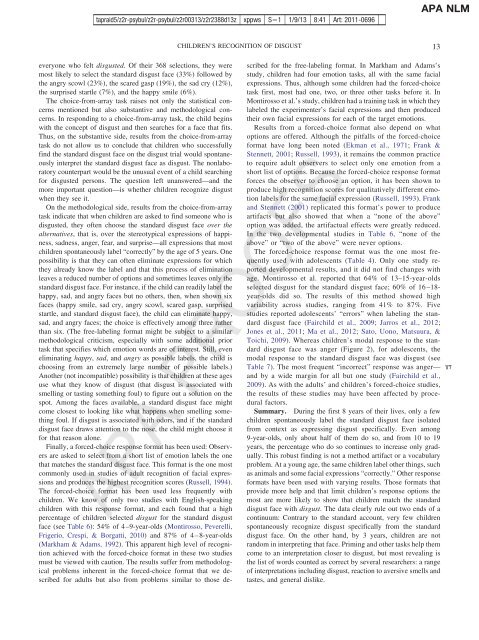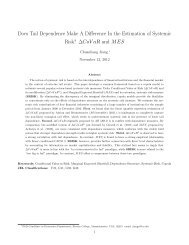Children's Recognition of Disgust in Others - Boston College
Children's Recognition of Disgust in Others - Boston College
Children's Recognition of Disgust in Others - Boston College
Create successful ePaper yourself
Turn your PDF publications into a flip-book with our unique Google optimized e-Paper software.
tapraid5/z2r-psybul/z2r-psybul/z2r00313/z2r2388d13z xppws S1 1/9/13 8:41 Art: 2011-0696APA NLMCHILDREN’S RECOGNITION OF DISGUST13everyone who felt disgusted. Of their 368 selections, they weremost likely to select the standard disgust face (33%) followed bythe angry scowl (23%), the scared gasp (19%), the sad cry (12%),the surprised startle (7%), and the happy smile (6%).The choice-from-array task raises not only the statistical concernsmentioned but also substantive and methodological concerns.In respond<strong>in</strong>g to a choice-from-array task, the child beg<strong>in</strong>swith the concept <strong>of</strong> disgust and then searches for a face that fits.Thus, on the substantive side, results from the choice-from-arraytask do not allow us to conclude that children who successfullyf<strong>in</strong>d the standard disgust face on the disgust trial would spontaneously<strong>in</strong>terpret the standard disgust face as disgust. The nonlaboratorycounterpart would be the unusual event <strong>of</strong> a child search<strong>in</strong>gfor disgusted persons. The question left unanswered—and themore important question—is whether children recognize disgustwhen they see it.On the methodological side, results from the choice-from-arraytask <strong>in</strong>dicate that when children are asked to f<strong>in</strong>d someone who isdisgusted, they <strong>of</strong>ten choose the standard disgust face over thealternatives, that is, over the stereotypical expressions <strong>of</strong> happ<strong>in</strong>ess,sadness, anger, fear, and surprise—all expressions that mostchildren spontaneously label “correctly” by the age <strong>of</strong> 5 years. Onepossibility is that they can <strong>of</strong>ten elim<strong>in</strong>ate expressions for whichthey already know the label and that this process <strong>of</strong> elim<strong>in</strong>ationleaves a reduced number <strong>of</strong> options and sometimes leaves only thestandard disgust face. For <strong>in</strong>stance, if the child can readily label thehappy, sad, and angry faces but no others, then, when shown sixfaces (happy smile, sad cry, angry scowl, scared gasp, surprisedstartle, and standard disgust face), the child can elim<strong>in</strong>ate happy,sad, and angry faces; the choice is effectively among three ratherthan six. (The free-label<strong>in</strong>g format might be subject to a similarmethodological criticism, especially with some additional priortask that specifies which emotion words are <strong>of</strong> <strong>in</strong>terest. Still, evenelim<strong>in</strong>at<strong>in</strong>g happy, sad, and angry as possible labels, the child ischoos<strong>in</strong>g from an extremely large number <strong>of</strong> possible labels.)Another (not <strong>in</strong>compatible) possibility is that children at these agesuse what they know <strong>of</strong> disgust (that disgust is associated withsmell<strong>in</strong>g or tast<strong>in</strong>g someth<strong>in</strong>g foul) to figure out a solution on thespot. Among the faces available, a standard disgust face mightcome closest to look<strong>in</strong>g like what happens when smell<strong>in</strong>g someth<strong>in</strong>gfoul. If disgust is associated with odors, and if the standarddisgust face draws attention to the nose, the child might choose itfor that reason alone.F<strong>in</strong>ally, a forced-choice response format has been used: Observersare asked to select from a short list <strong>of</strong> emotion labels the onethat matches the standard disgust face. This format is the one mostcommonly used <strong>in</strong> studies <strong>of</strong> adult recognition <strong>of</strong> facial expressionsand produces the highest recognition scores (Russell, 1994).The forced-choice format has been used less frequently withchildren. We know <strong>of</strong> only two studies with English-speak<strong>in</strong>gchildren with this response format, and each found that a highpercentage <strong>of</strong> children selected disgust for the standard disgustface (see Table 6): 54% <strong>of</strong> 4–9-year-olds (Montirosso, Peverelli,Frigerio, Crespi, & Borgatti, 2010) and 87% <strong>of</strong> 4–8-year-olds(Markham & Adams, 1992). This apparent high level <strong>of</strong> recognitionachieved with the forced-choice format <strong>in</strong> these two studiesmust be viewed with caution. The results suffer from methodologicalproblems <strong>in</strong>herent <strong>in</strong> the forced-choice format that we describedfor adults but also from problems similar to those describedfor the free-label<strong>in</strong>g format. In Markham and Adams’sstudy, children had four emotion tasks, all with the same facialexpressions. Thus, although some children had the forced-choicetask first, most had one, two, or three other tasks before it. InMontirosso et al.’s study, children had a tra<strong>in</strong><strong>in</strong>g task <strong>in</strong> which theylabeled the experimenter’s facial expressions and then producedtheir own facial expressions for each <strong>of</strong> the target emotions.Results from a forced-choice format also depend on whatoptions are <strong>of</strong>fered. Although the pitfalls <strong>of</strong> the forced-choiceformat have long been noted (Ekman et al., 1971; Frank &Stennett, 2001; Russell, 1993), it rema<strong>in</strong>s the common practiceto require adult observers to select only one emotion from ashort list <strong>of</strong> options. Because the forced-choice response formatforces the observer to choose an option, it has been shown toproduce high recognition scores for qualitatively different emotionlabels for the same facial expression (Russell, 1993). Frankand Stennett (2001) replicated this format’s power to produceartifacts but also showed that when a “none <strong>of</strong> the above”option was added, the artifactual effects were greatly reduced.In the two developmental studies <strong>in</strong> Table 6, “none <strong>of</strong> theabove” or “two <strong>of</strong> the above” were never options.The forced-choice response format was the one most frequentlyused with adolescents (Table 4). Only one study reporteddevelopmental results, and it did not f<strong>in</strong>d changes withage. Montirosso et al. reported that 64% <strong>of</strong> 13–15-year-oldsselected disgust for the standard disgust face; 60% <strong>of</strong> 16–18-year-olds did so. The results <strong>of</strong> this method showed highvariability across studies, rang<strong>in</strong>g from 41% to 87%. Fivestudies reported adolescents’ “errors” when label<strong>in</strong>g the standarddisgust face (Fairchild et al., 2009; Jarros et al., 2012;Jones et al., 2011; Ma et al., 2012; Sato, Uono, Matsuura, &Toichi, 2009). Whereas children’s modal response to the standarddisgust face was anger (Figure 2), for adolescents, themodal response to the standard disgust face was disgust (seeTable 7). The most frequent “<strong>in</strong>correct” response was anger— T7and by a wide marg<strong>in</strong> for all but one study (Fairchild et al.,2009). As with the adults’ and children’s forced-choice studies,the results <strong>of</strong> these studies may have been affected by proceduralfactors.Summary. Dur<strong>in</strong>g the first 8 years <strong>of</strong> their lives, only a fewchildren spontaneously label the standard disgust face isolatedfrom context as express<strong>in</strong>g disgust specifically. Even among9-year-olds, only about half <strong>of</strong> them do so, and from 10 to 19years, the percentage who do so cont<strong>in</strong>ues to <strong>in</strong>crease only gradually.This robust f<strong>in</strong>d<strong>in</strong>g is not a method artifact or a vocabularyproblem. At a young age, the same children label other th<strong>in</strong>gs, suchas animals and some facial expressions “correctly.” Other responseformats have been used with vary<strong>in</strong>g results. Those formats thatprovide more help and that limit children’s response options themost are more likely to show that children match the standarddisgust face with disgust. The data clearly rule out two ends <strong>of</strong> acont<strong>in</strong>uum: Contrary to the standard account, very few childrenspontaneously recognize disgust specifically from the standarddisgust face. On the other hand, by 3 years, children are notrandom <strong>in</strong> <strong>in</strong>terpret<strong>in</strong>g that face. Prim<strong>in</strong>g and other tasks help themcome to an <strong>in</strong>terpretation closer to disgust, but most reveal<strong>in</strong>g isthe list <strong>of</strong> words counted as correct by several researchers: a range<strong>of</strong> <strong>in</strong>terpretations <strong>in</strong>clud<strong>in</strong>g disgust, reaction to aversive smells andtastes, and general dislike.
















